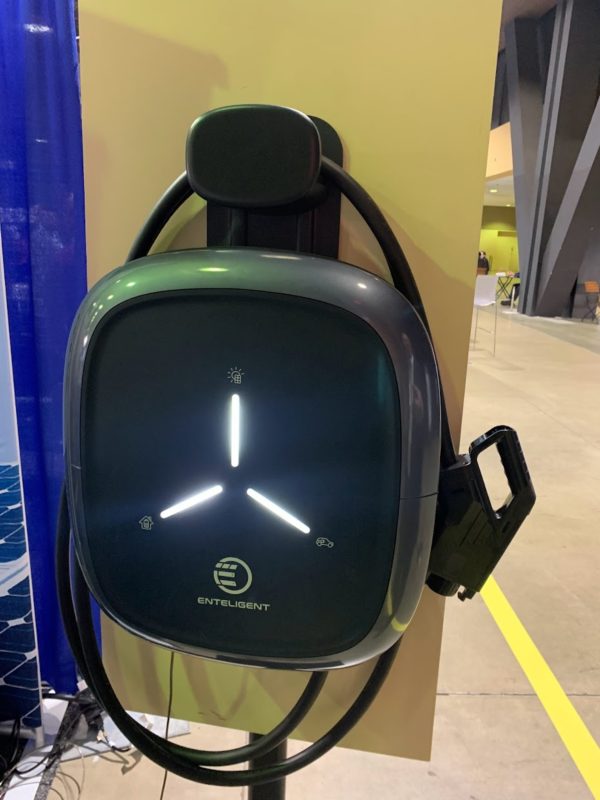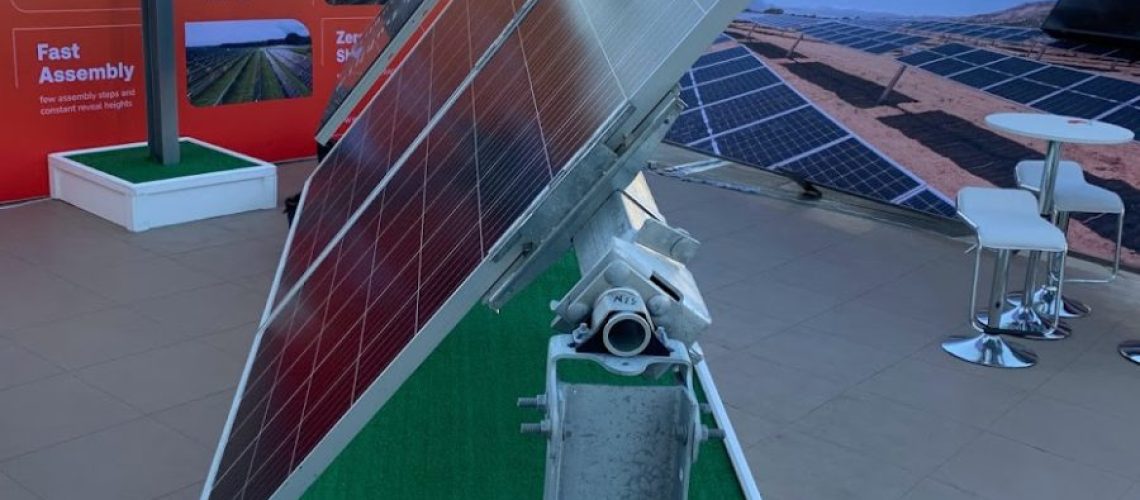With the handing down of NEM 3.0 still fresh in mind for the California solar market, much focus at Intersolar North America and Energy Storage North America 2023 this week in Long Beach, Calif., was on an integrated residential battery storage system paired with solar and EV charging systems.
The event, held Feb. 14 – 16 at the Long Beach Convention & Entertainment Center, is dedicated to advancing the clean energy transition, featured four keynote addresses, 300+ exhibiting companies, the third annual Solar Games installer competition, and valuable distributed energy panel sessions and networking opportunities.
FranklinWH Energy Storage Inc., a specialist in whole-home energy management, saw throngs of visitors at its booth on the exhibit floor. The San Jose, Calif.-based company was demonstrating its residential battery system, which has shown a five to 15 minute commissioning time.
The company’s energy storage system debuted over a year ago and is made in Shenzhen, China. The system integrates a 13.6 kWh lithium iron phosphate “aPower” battery with adaptive learning, part of the aGate smart control system. FranklinWH reports the battery is compatible with any PV inverter technology, and it can connect with existing solar systems while scaling up to 15 units for a total of 204 kWh of capacity. In the event of a power failure, its “black start” feature creates a micro-grid for the home.
Nearby, electric panel startup SPAN.io Inc., also headquartered in San Francisco, was showing off an EV charging plug interconnected with its digital and off-grid electric panel system, housed in a mobile tiny house trailer. The company reports that it enables residential electrification without replacing infrastructure like wires and transformers.
Unlike a traditional electrical panel, SPAN provides circuit-level control and digital real-time usage to energy consumption at the appliance level of the house. When paired with solar and storage, makes the home self-reliant and sustainable during a power outage by enabling flexible backup. At Intersolar the SPAN panel was paired with Enphase home battery systems and can also be paired with Tesla Powerwall, among others. The SPAN panel retails for $4,500 before professional installation and tax.
Among new EV solutions debuted at Intersolar was Enteligent’s EV Fast Charger, a 25 kW home and commercial-scale DC to DC charging port which allows daily charging directly from solar generation. Without the conversion of solar photovoltaic energy from DC to AC at the grid level first, Enteligent’s wall-mount and ballast configurable charger adds back 13 to 20% of lost energy from traditional AC home charging systems. The small charger is about the size of traditional home EV chargers and doesn’t require additional batteries or electrical infrastructure upgrades.
The company’s chief executive officer Sean Burke told pv magazine USA that the first Enteligent fast chargers will be delivered in Q3 2023. The company recently closed on a $7 million Series A round from NOVA, the venture arm of Saint-Gobain, and Taronga Ventures, a real estate technology investor.

Utility-scale innovation
Across the exhibit hall at Intersolar North America, a number of utility solar operations and maintenance solutions vendors were showing off their solutions. After Zeitview (formerly Dronebase) showed its new North American Solar Scan, an asset rating system for utility solar projects, it was easy to see the value in O&M solutions at Intersolar.
Two such firms, Bird Control Group and RST CleanTech, are literally removing the crap from dirty panels in coastal regions or areas with regular migratory birds.
Using the Avix Autonomic laser system, Bird Control Group provides a 5,000-hour, 360-degree green laser gun that is mounted on a tripod or racking system adjacent to a solar project. The laser senses incoming birds in its periphery and deters birds from flying above or around solar systems, providing a 90% reduction in birds and bird poop from reducing the efficiency of solar panels within a range of 1,640 yards, just shy of one mile.
Ihor Mulyck, sales manager at Bird Control Group, told pv magazine USA that the laser systems were developed by its Danish parent company, and typically sell for $15,000, including installation and O&M services.
Matt Casey, owner of RST North America, the U.S. business of Israel-based RST Cleantech Solutions, said RST sells and maintains a sprinkler system network that cleans 2 million solar PV panels each day across systems that average 20 MW per project.
RST’s sprinkler mounted on PV modules improves efficiency by up to 35%, and Casey told pv magazine USA that many of its commercial and industrial customers have assets more than a decade in service that are performing at peak performance. Using a mobile phone application, RST’s sprinkler systems are deployed on panels to discharge water to clean panels during the night time, with projects routinely cleaned about every 10 to 14 days to maintain efficiency.
“Without cleaning, it’s like buying a movie ticket and not going to the movie performance,” Casey said about the U.S. solar market that has not yet fully embracing solar cleaning solutions. “There’s a real gap in solutions. EPCs [engineering, procurement & construction] just want to install projects and not worry about anything else.”
The Israeli company reports that it cleans approximately 40% of the Middle Eastern country’s PV systems, and Casey said the company expects to achieve a similar metric in the U.S. in the coming years. In addition to its sprinkler nozzle and tubing system being evaluated for inclusion in solar investment tax credit status, Casey said RST’s systems are beneficial to agrivoltaic system usage, as its water-based cleaning systems use no chemicals, are deployed overnight using water conservation, and excess water flows to the ground level to water plants or nearby bushes or shrubs.
Outside the Long Beach Convention Center, Nevados Engineering’s All Terrain Tracker was on display, equipped with First Solar Series 6 modules. The Nevados tracker provides for ground-mounted installations at slopes of up to 37% in any direction, allowing for 96 modules to be installed in a single row. The trackers are designed to fully eliminate site grading constraints in projects with uneven terrain. This avoids time and cost-intensive permitting, construction, and revegetation steps, and accelerates project schedules, according to a product circular.
The All Terrain Tracker system’s torque tube and damper designs improve wind performance and has been tested at hurrican force winds of 80 miles per hour.
Mark your calendars: Intersolar North America and Energy Storage North America 2024 returns to San Diego, Calif. next year, taking place January 17 to 19, 2024.



